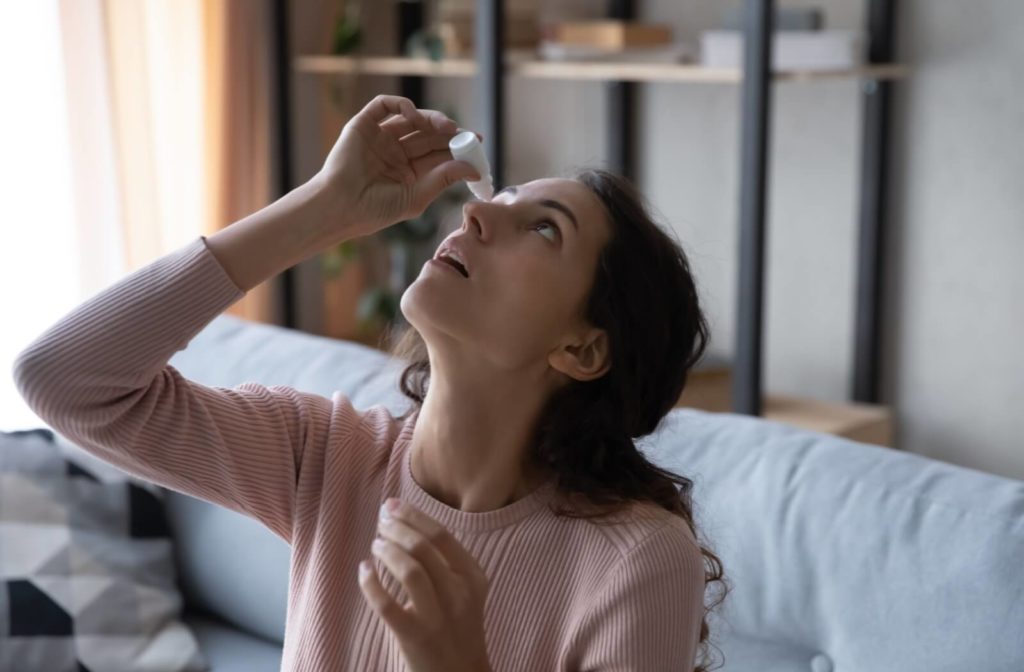If you’ve ever found yourself constantly rubbing at your eyes—almost as if there’s a piece of sandpaper trapped underneath the eyelids—you were probably dealing with dry eye syndrome. This condition can easily be recognized by the fact that it causes blurry vision as well as burning and stinging sensations in the eyes. However, many people also find themselves dealing with headaches in addition to having dry eyes. Are these two sets of symptoms linked, or is there something more to it?
Dry eyes and headaches are closely linked, but one doesn’t cause the other. These two conditions share similar causes and can aggravate each other, making the discomfort much more noticeable. If you frequently deal with dry eyes and headaches simultaneously, visit your optometrist to discuss solutions.
What Is Dry Eye?
Your tear film isn’t just a way to express emotions—it’s crucial for the overall health of your eye. Your tears help keep the eye protected by providing essential nutrients and the ability to flush away harmful particles.
To function, the tear film needs 3 layers:
- Water, to flush away bacteria and nourish the eye
- Oils, to prevent tear evaporation
- Mucus, to spread the moisture evenly across the eye
When the balance of these layers is disrupted, your eyes are no longer protected. This can lead to irritation and discomfort, and may feel like the surface of your eye is burning. This is dry eye syndrome.
The Types of Dry Eye Syndrome
There are 2 types of dry eye:
- Aqueous deficiency dry eye, which occurs when your eyes don’t produce enough tears. This means that the eye doesn’t produce the right quantity of tears, causing it to dry out.
- Evaporative dry eye, which occurs when there aren’t enough oils for your tears. This means that the tears evaporate too quickly due to poor quality.
So what causes dry eye syndrome—and what can you do about it?
What Causes Dry Eye Syndrome?
Dry eye syndrome can be triggered by numerous factors. Your environment plays a significant role here—if you’re frequently exposed to dust, dirt, wind, or dry air, you’re much more likely to develop dry eyes.
Dry eyes can also develop due to:
- Poor nutrition and lifestyle habits
- Medical conditions like Sjogren’s syndrome or diabetes
- Hormonal changes, particularly in women during menopause
- Long-term use of contact lenses
- Certain medications, such as antihistamines or antidepressants
- Aging, as tear production tends to decrease with age
When you’re trying to treat dry eyes, it’s crucial to address the underlying cause. This way, you can stop the symptoms before they start and find quick relief.
Common Symptoms of Dry Eye
Regardless of the specific type of dry eye syndrome, the symptoms remain the same—a constant stinging and burning sensation in the eyes that quickly disrupts everyday life. Dry eye syndrome often causes:
- Redness and swelling
- Blurry vision
- Sensitivity to light
- Excessive tearing
These symptoms can worsen if you don’t address the problem. Dry eye syndrome isn’t just about temporary discomfort, though; it can also increase your risk of damaging your eyes while they’re unprotected.
Dry Eyes & Headaches
The link between dry eyes and headaches can seem confusing at first. Many people who experience migraines also deal with dry eyes, begging the question of whether or not one condition can cause the other.
The connection is believed to be the underlying cause of each condition, rather than dry eyes causing headaches or vice versa. Both dry eyes and headaches can be caused by lifestyle habits like poor nutrition and diet or exposure to harsh environments and lighting.
Rather than dry eyes causing headaches, it’s believed that they amplify the other’s symptoms. Dry eyes can lead to light sensitivity and inflammation, which in turn can make migraine symptoms worse. The resulting strain and irritation can cause you to squint, which can contribute to muscle tension around the eyes and forehead.
Meanwhile, it’s also worth noting that many people who frequently experience migraines and dry eyes simultaneously even have a slightly different ocular structure. While not yet fully understood, this could be causing one—or both—of the mentioned conditions.
How to Treat Dry Eyes
The good news is that there’s no need to suffer from dry eye syndrome in silence. There are plenty of treatments available for the condition—all you need to do is visit your optometrist. They’ll assess your eyes and vision to determine what’s causing your dry eyes, and they may even be able to find out what’s behind your constant headaches.

Here at York Mills Eye Care, we have 3 key approaches to dealing with dry eye syndrome:
- Artificial tears. These are excellent for finding relief when.
- Medicated eye drops. These can help stimulate the healthy production of your tear film to prevent the onset of dry eye symptoms.
- Hypochlorous disinfectant treatment. This is a special treatment designed to clean the areas around your eyes, preventing the buildup of bacteria. It helps prevent the irritation and inflammation caused by dry eyes and can be an excellent way to find long-lasting relief.
Remember—finding treatment for dry eye syndrome isn’t just about temporary relief. It’s about investing in your future and safeguarding your vision against potential problems.
Find Relief from Your Dry Eyes
If you’re dealing with dry eyes and headaches, don’t suffer in silence. Instead, come see our team at York Mills Eye Care. We can find out what’s causing your symptoms and give you a personalized treatment plan going forward. Book an appointment with us today, and let’s work together to find you the relief you deserve.




